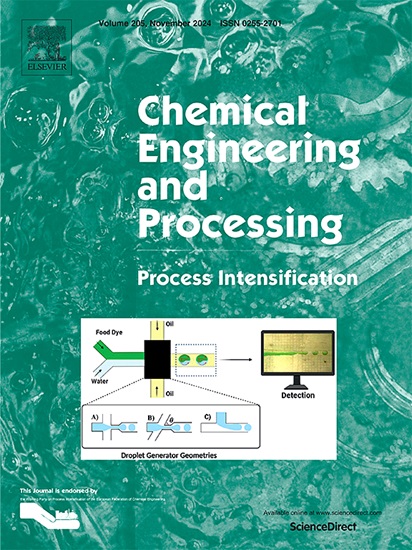Optimizing the microchannel geometry for effective control of analyte band dispersion
IF 3.8
3区 工程技术
Q3 ENERGY & FUELS
Chemical Engineering and Processing - Process Intensification
Pub Date : 2025-02-11
DOI:10.1016/j.cep.2025.110221
引用次数: 0
Abstract
Managing analyte band dispersion is a critical challenge in diagnostic systems, medical spectroscopy, chromatography, and drug delivery devices. Effective dispersion control ensures reliable measurements, enhanced resolution, heightened sensitivity, and improved system performance. This study emphasizes the importance of optimizing microchannel geometries, particularly curvature sections, to effectively control analyte band dispersion. To achieve this, four microchannel geometries, namely Type I to Type IV, each with distinct curvature differences, were analyzed to identify the optimal geometry with the lowest dispersion. Key parameters, including wall zeta potential, applied voltage, and the internal-to-external curvature radius ratio, were examined for their influence on dispersion. The finite element method was employed to solve the Laplace and Navier-Stokes equations for electric field and velocity distributions, while the unsteady-state diffusion-convection equation determined analyte concentration profiles. Results showed that dispersion reductions after optimization were 60 % for Type II, 48 % for Type III, and 32 % for Type IV microchannels, nevertheless for Type I microchannel dispersion remain constant after and before optimization about 70 %. Increasing the zeta potential from ζ = -0.1 V to ζ = -0.5 V led to a significant rise in dispersion from 25 % to 90 % post-optimization. Conversely, adjusting the curvature ratio Rr from 0.1 to 0.5 decreased dispersion from 42 % to 15 %. These findings underscore the importance of precise dispersion control in advancing analytical systems such as lab-on-disk and lab-on-chip technologies. This research provides valuable insights for optimizing microchannel designs to enhance the performance and reliability of various analytical and diagnostic applications.

优化微通道几何结构,有效控制分析物色散
管理分析物带色散是诊断系统、医学光谱、色谱和药物输送设备的关键挑战。有效的色散控制确保可靠的测量,增强分辨率,提高灵敏度和改进的系统性能。这项研究强调了优化微通道几何形状的重要性,特别是曲率截面,以有效地控制分析物带色散。为了实现这一目标,研究人员分析了四种微通道几何形状,即I型到IV型,每种形状都有不同的曲率差异,以确定具有最低色散的最佳几何形状。考察了壁电位、外加电压和内外曲率半径比等关键参数对色散的影响。采用有限元法求解电场和速度分布的Laplace方程和Navier-Stokes方程,采用非稳态扩散对流方程确定分析物浓度分布。结果表明,优化后的II型微通道色散减少了60%,III型微通道色散减少了48%,IV型微通道色散减少了32%,而I型微通道在优化前后色散保持不变,约为70%。将ζ电位从ζ = -0.1 V增加到ζ = -0.5 V导致色散从优化后的25%显著增加到90%。相反,将曲率比Rr从0.1调整到0.5可使色散从42%降低到15%。这些发现强调了精确色散控制在推进分析系统(如磁盘实验室和芯片实验室技术)中的重要性。本研究为优化微通道设计提供了有价值的见解,以提高各种分析和诊断应用的性能和可靠性。
本文章由计算机程序翻译,如有差异,请以英文原文为准。
求助全文
约1分钟内获得全文
求助全文
来源期刊
CiteScore
7.80
自引率
9.30%
发文量
408
审稿时长
49 days
期刊介绍:
Chemical Engineering and Processing: Process Intensification is intended for practicing researchers in industry and academia, working in the field of Process Engineering and related to the subject of Process Intensification.Articles published in the Journal demonstrate how novel discoveries, developments and theories in the field of Process Engineering and in particular Process Intensification may be used for analysis and design of innovative equipment and processing methods with substantially improved sustainability, efficiency and environmental performance.

 求助内容:
求助内容: 应助结果提醒方式:
应助结果提醒方式:


